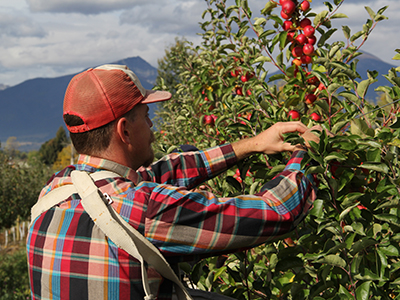Alexander
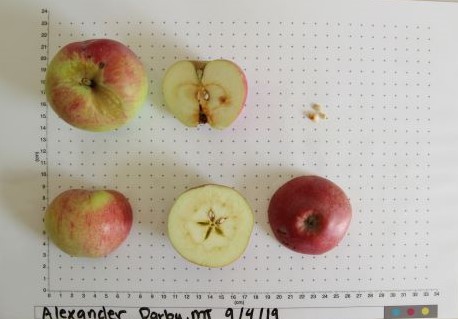
Fruit Description
Size: Large, occasionally very large
Shape: round to conical, irreguular to angular with some ribbing may be regular. Can be lopsided. Tapers to toward apex and may display slight five crowning.
Skin: Green to yellow green with crimson red or carmine striped blush. Occasional dots variable in size and color giving a mottled appearance. Often aereolar. Some russeting extends cavity but generally rare. Thick, tough, smooth skin, can become waxy or greasy in storage.
Stalk (stem) and Cavity: Stem equal to cavity or protruding, medium to long can be knobbed or clubbed at the base. Cavity acute to acuminate, symmetrical to lopsided can be lipped. Thick often bumpy russet radiates from cavity.
Basin: Small or narrow, somewhat furrowed, ribbed wavy or uneven. Occasional russeting in basin.
Calyx (Eye): Partially open, medium to large with stamens often visible.
Core (Vertical): Core line clasping sometimes median, axile, wide. Variable tube form and size typically cone or funnel.
Carpels and Axial Sac (Transverse): Carpels narrow, elliptical or pointed. Axial sac small to medium cyndrical.
Seeds: Plump, pointed, few, dark brown at maturity.
Flesh: Yellowish white, whitish green when immature. Coarse, juicy, crisp.
Flavor: Acid to subacid.
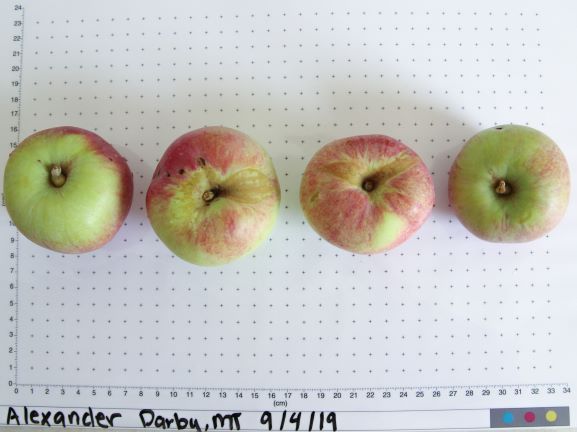
Additional Notes
Synonyms: 'Emperor', 'Emperor Alexander', 'Beauty of the West', 'Russian Emperor, 'Summer Queen of Missouri', 'Grand Alexander', 'English King', 'Princess Louise', 'Belle de Bruxelles'. May or may not be the same as 'Aport', 'Aporta' or 'Oporto'.
First Recorded: 1700, introduced to U.S. circa 1817
Origin: Possibly Ukraine
Bloom time: Mid
Harvest: Late
Use: Fresh eating, culinary
Storage: Poor
Disease: resistant to scab, susceptible to fire blight.
Parentage: Unknown
Frequency in Montana Orchards based on DNA testing: Low
Lookalikes: 'Wolf River'
History
In the early 1800's, pioneers were moving north and west into colder regions of the United States. European cultivars and their American seedlings could not withstand the harsh winters of WI, MN and northern New England. Seeing the need to bring new cold hardy apples to America, the Massachusetts Horticultural Society partnered with the London Horticultural Society to import four Russian cultivars, 'Tetovsky', 'Red Astrachan', 'Duchess of Oldenburg' and 'Alexander'. While the exact origins of all four apples are unknown they became associated with the Russian Empire and were all imported to the United States around 1835 via London. It is believed 'Alexander' may have arrived before this around 1817 which is also when it was exhbited in England by the London Horticultural Society. In Montana, 'Alexander' was mentioned in reports from 1900 as being planted in Missoula and Ravalli Counties and reportedly a cultivar "successful in nearly every part of Montana" by the Montana State Board of Horticulture in 1906.
Additional Photos
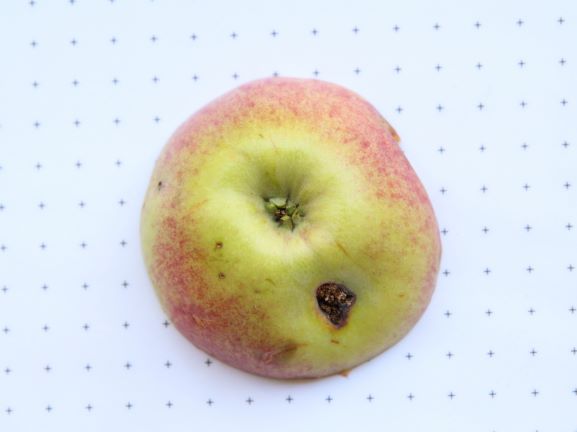
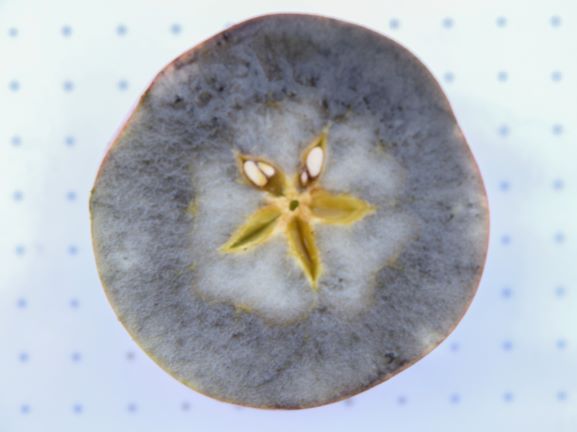
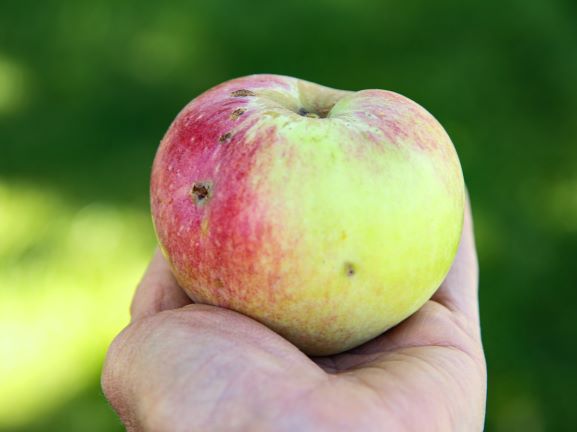
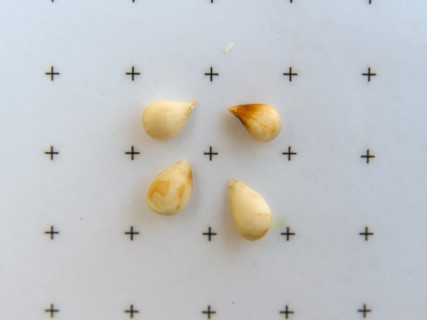
References
Applename.com, 'Alexander.' Viewed online February 11, 2021. http://www.applename.com/varieties/alexander.
Bunker, J. (2019). Apples and the Art of Detection.
Bussey, D. J., & In Whealy, K. (2016). The illustrated history of apples in the United States and Canada.
FruitID.com, "Alexander". Viewed online February, 11, 2021. https://www.fruitid.com/#view/445.
Volk, G. M., & Henk, A. D. (2016). Historic American Apple Cultivars: Identification and Availability, Journal of the American Society for Horticultural Science J. Amer. Soc. Hort. Sci., 141(3), 292-301. Retrieved Feb 15, 2021. https://journals.ashs.org/jashs/view/journals/jashs/141/3/article-p292.xml
Woody, F. L. “The First Fruit Trees in Montana.” Proceedings of the Twelfth Annual Session of the Montana Horticultural Society, Billings, Feb. 9-11, 1909: 30.

